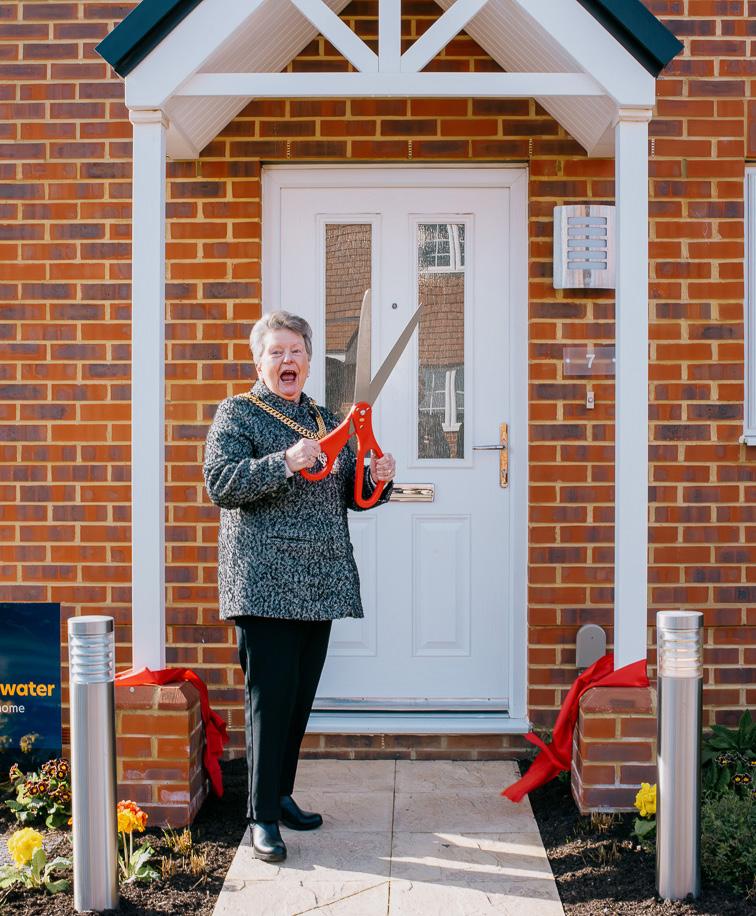ISSUE 21: APRIL 2025
‘We need to shout louder about DEI’
Preparing for Awaab’s Law
HQM investigates the surge in right to buy applications

ISSUE 21: APRIL 2025
‘We need to shout louder about DEI’
Preparing for Awaab’s Law
HQM investigates the surge in right to buy applications
15 and 17 July 2025
What can social landlords do to meet housing need, provide safe, decent homes and improve the quality of life for residents and communities in this uncertain world with fewer resources? Join us to explore these challenges and your options for the future.
Held over two days, the first will be a virtual event and the second an opportunity to get together with colleagues at our central London venue, The View.
Key sessions include:
• Florence Eshalomi MP, Chair of the Housing, Communities and Local Government Committee, reflecting on what the government should be doing on social housing
• Ash Sarkar, journalist and leading political commentator on the culture wars
• Keon West, professor of social psychology at the University of London, on the themes and findings of his new book, The Science of Racism
• Kate Dodsworth, reflecting on a year of consumer regulation and inspection
• The Housing’s Next Generation Grand Final.



10
‘We need to shout louder about DEI’
Neil Merrick looks into the galvanising effect that Donald Trump is having on diversity in UK housing
14 Preparing for Awaab’s Law
HQM takes a look at how social housing providers are preparing for new legislation to fix homes
18 HQM investigates
Keith Cooper examines the effects of the government’s recent changes to right to buy discounts
22 Interview: Florence Eshalomi
Jon Land talks to the chair of the MHCLG Select Committee
research and analysis – in plain English
Design:
Published four times a year. All rights reserved. Reproduction in whole or in part without written permission is strictly
Ensuring that we are fully ready for the introduction of Awaab’s Law in October 2025 is crucial. This training course will equip delegates with the knowledge and skills required to understand and comply with the new legal requirements, ensuring safe and healthy living conditions for tenants.

This training session will develop an understanding of the Housing Health and Safety Rating System (HHSRS) and the importance of hazard awareness. Delegates will gain insight into how these regulations will impact landlords and tenants and what steps need to be taken to remain compliant.
To find out more, please visit hqnetwork.co.uk/events/an-introduction-toawaabs-law-for-non-technical-staff



There’s a theme running through this edition of HQM that’s not entirely deliberate on our part – highlighting the unintentional consequences of government policy.
There’s no doubt that since Labour came to power in July 2024, housing has been near the top of the agenda and, on paper, much of what the government has announced to date seems laudable: build more homes, reform right to buy, force landlords to fix poor-quality homes – the list is quite impressive.
But nine months on, perhaps in a rush to get things done, a series of policy missteps have become apparent that suggest some of the detail hasn’t been thought through. There are at least three examples in this edition.
The most obvious ‘unintentional consequence’ was originally brought to our attention by members of HQN’s Leasehold Network, who raised concerns at the huge number of right to buy applications they had received after the government announced it would drastically reduce discounts in last year’s autumn statement. We asked our specialist housing reporter Keith Cooper to investigate the claims and the shocking results are published in one of our main features.
While there’s little doubt that the government’s intentions to reduce the number of social homes lost through the right to buy are spot on, putting a deadline in place where the discount level drops overnight has caused chaos for local authorities and created a surge in applications.
Another example crops up in our exclusive interview with Florence Eshalomi, chair of the Housing, Communities and Local Government Select Committee. On the one hand, Florence is full of praise for the government’s efforts to tackle homelessness, but she feels this useful work has been undone by the decision to refreeze local housing allowance, which estimates show will pull 50,000 private renters into poverty and potentially put them at risk of homelessness.
There are also concerns that the introduction of Awaab’s Law – widely welcomed by renters, campaigners and many housing providers – will put landlords under additional financial pressure as they race to fix homes within strict timescales. There are also fears it could lead to a deluge of costly and time consuming disrepair claims. Our feature on how landlords are preparing digs into the detail.
Elsewhere in this edition, we look at the future of equality, diversity and inclusion in housing as the fallout from Donald Trump’s efforts to end ‘wokeness’ in the US starts to be felt in this country.

Jon Land Editor, HQM
‘How do we get shared ownership back on track?’
You’ve got to feel for Angela Rayner. She’s trying to build as many homes as possible, but it must seem like everything is against her. The latest setback is a national shortage of bricks. Already experts are telling her to use all manner of weird and wonderful alternatives to bricks. Have we forgotten the lessons of the Three Little Pigs? Come on Bridget Phillipson, get that salutary tale back on the curriculum.
A big part of Angela’s plans will likely be to boost shared ownership. But it’s getting a bad press as service charges rocket and satisfaction drops.
Cometh the hour, cometh the man. Leeds Building Society sent for the legendary housing professor Peter Williams to look independently at the costs of shared ownership. He tested out whether or not shared ownership was cheaper than private renting. That’s a good question. If it’s not
“Thanks to the RSH’s Tenant Satisfaction Measures we can see how the new players are doing on shared ownership. It’s not great. Only L&G scrape into the top 10 for satisfaction. Sage (now Sparrow) come in at 15, with Heylo lagging behind at 21”
cheaper, shared ownership falls at the first hurdle – it’s just not affordable housing. Overall, shared ownership passes the test. Across 294 council areas, shared ownership is cheaper than private renting in 77% of locations in year one rising to 93% by year 10. Shared ownership does better in high rent areas where it’s cheaper than renting privately across 90% to 98% of areas over 10 years.
On top of that Peter says that shared owners will be on average £29,000 better off due to equity growth. Now that’s a big plus. But will this always happen? The Times reports that 60% of McCarthy Stone flats lost money on resale. The owner was worse off by £41,000 on average. Why does this matter? Homes England have given the firm £94million to move into building shared ownership homes. Let us hope that these new flats buck the trend and don’t fall in value. It’s a high stakes game. The Times headline was – “Families lose ‘life savings’ on developer’s retirement flats.”
If you are struggling to pay service charges in flats the idea that shared ownership is a bargain might not ring true for you. So is the answer to restrict shared ownership to houses. Running costs will be lower and satisfaction is usually much higher. The obvious problem is that we need greater density in higher value areas. Sadly opting for houses only isn’t the solution everywhere. What else could we try?
How about shaking things up? What about a bit of disruptive innovation? It has worked wonders in personal banking. New players like Chase, Monzo and Starling top the satisfaction
charts. They lead the best of the old guard, Nationwide, by at least 10%.
Thanks to the RSH’s Tenant Satisfaction Measures we can see how the new players are doing on shared ownership. It’s not great. Only L&G scrape into the top 10 for satisfaction. Sage (now Sparrow) come in at 15, with Heylo lagging behind at 21.
Why is it that Chase, fresh out of NYC, has come in and blown away the opposition? Blackstone (who back Sage) and Blackrock (who back Heylo) have got to take a long, hard look at themselves. They’re just not doing what they need to do. The big bosses in NYC will rightly be demanding action. But until then, the stimulus of competition isn’t helping shared ownership.
Perhaps the answer is to change the legal set up for managing blocks. I’m often told that things are so much better in Scotland. Yet, the papers up here carry tales of huge bills and mistakes by managing agents (or factors as we call them).
So, there are no quick and easy fixes. How would I start to get shared ownership back on track?
We have to move on from mutually assured destruction. Campaigns against particular associations and agents can backfire. No one in their right mind will want to buy a flat where the association or agent is slated day in and day out on socials. That hits sales of new homes by the association and resales by shared owners with equal force.
For the avoidance of doubt, I don’t disagree

“We have to move on from mutually assured destruction...No one in their right mind will want to buy a flat where the association or agent is slated day in and day out on socials. That hits sales of new homes by the association and resales by shared owners with equal force”
with the complaints. It’s the case that some associations have bitten off more than they can chew, and all too often blame everyone but themselves for the problems. The associations must look lively to defuse the criticism and get to a point where shared ownership enjoys a better reputation.
I’m happy to report that the CEO of one of the most heavily criticised associations is reaching out to residents and campaigners. He’s certainly saying all the right things. So, I’ve high hopes for glasnost. But he’s going to have to reverse years of unhappiness. And a group of MPs will be keeping a beady eye.
In the here and now the acid test is to get the bills down. That means taking on the managing agents more vigorously. Or at least trying a bit harder than some do.
Long term, we must never let development departments rule the roost again. Too often they drove around like wee pretendy entrepreneurs spending other people’s money on towers of Babel. Such blocks are a trial for the housing managers and repair staff who must pick up the pieces. More importantly, they cause nothing but misery for the residents who dread the bills, aka a tax on complexity.
Let’s look before we leap as landlords and work out what a block will cost to live in before we pounce. And do some stress testing to allow for the unexpected.

Alistair McIntosh, Chief Executive, HQN

By Helen Knight, Communications Officer, Trent & Dove Housing
With the introduction of Awaab’s Law this October, housing associations are taking vital steps forward, introducing stringent timeframes to swiftly address damp and mould cases.
Trent & Dove has already taken a proactive approach by incorporating the upcoming legislative changes into its recent repairs redesign.
Alongside the timeframe changes already implemented to improve its repairs process and promptly identify damp and mould cases, the redesign improves customer communication by integrating the customer relationship
management (CRM) and repairs systems. This ensures colleagues can access the latest accurate information from when a repair is reported to completion.
They can also log a repair – even while in a customer’s home.
This is made possible thanks to an interdepartmental working group, consisting of repairs, IT and customer services teams.
The communication improvements align with the latest consumer standards introduced by the Regulator of Social Housing. These aim to ensure customers have clear communication and consistently good service from their landlord.
Trent & Dove’s repairs policy historically consisted of only

two priorities: a standard repair timeframe of 28 days and an emergency category actioned within 24 hours.
Trent & Dove’s head of property services, Nick Sutton, said: “Sometimes we couldn’t keep to that timeframe because of the amount of work involved in some repairs.
For example, we would find it challenging to get a subcontractor to erect a scaffold, undertake the necessary roofing works, then remove it within this timeframe.
“We would also find that some specialist order items – such as ventilation systems –weren’t immediately available.
“Our historic priorities meant that we were trying to meet unrealistic timeframes.
“Expectations around damp and mould are also increasing which is having an impact on our average job costs as well as the fact that we’re now undertaking much more complex repairs on a larger scale.

“All these factors made us review our current working practices and it was decided that if we were going to make changes then we’d consider all options.”
So, a new repairs policy was born, led by Nick Sutton, repairs manager Richard Thornewill, and business improvement and procurement officer Clare Evans in consultation with Trent & Dove’s customer committee.
Emergency repairs remain unchanged, but the scheduled repair category aims to ensure work is completed within 20 working days. It was previously 28 calendar days. Under a new programmed and major repairs priority system, work, such as complex repairs and component replacements, aims to be completed within 60 to 90 working days. This is communicated to the customer from the start.
The importance of the repairs redesign has been strengthened with the introduction of Awaab’s Law.
As the team compiled their policy, early details of Awaab’s Law started to filter through. Trent & Dove decided to “get ahead of the game”, taking on the timescales guidance and incorporating this into their redesign.
As an additional step, Trent & Dove’s specialist damp and mould team attend the property to reduce any severity while its report is produced within 48 hours. The team then has seven days from the date of the report to complete or start the work.
“Expectations around damp and mould are also increasing which is having an impact on our average job costs as well as the fact that we’re now undertaking much more complex repairs on a larger scale”
Nick Sutton, head of property services, Trent & Dove
The system now enables the surveying team to track progress and assist them in meeting the timescales from initial stage, and the milestones in between, to completion.
To support these timescales, colleagues can, where possible, join a video call with residents to quickly identify any damp and mould cases without waiting for a surveyor appointment.

Sutton
However, while Trent & Dove ensured they could support the new timeframes, they needed the IT infrastructure.
The main focus was rebuilding the repairs picker, making it easier to accurately log a repair on the CRM and ensuring that customers, regardless of who they speak to, receive the same level of service.
“Following customer feedback, we found many expected a 28-day turnaround on their repairs. When this couldn’t be achieved, our IT system meant customer services could not see whether the work would be completed on time. Now, all colleagues see every update for a repair including those made by the operative.
“It has become more transparent, and everyone can see what’s happening.”
System errors affecting appointments – where confirmation was only received when both systems matched – were also resolved.
It’s been a long process to support the massive improvements involved, coupled with IT that couldn’t support the infrastructure at the time.
“It’s a huge customer-focused approach and we’re already in a good position to meet the requirements of Awaab’s Law.”

Since Donald Trump became US president at the start of 2025, he’s set about cutting funding to “radical and wasteful” diversity, equity and inclusion programmes and is urging other countries to do the same. But even though the housing sector needs to do better, his rhetoric seems to be having a galvanising effect, as Neil Merrick finds out.

More than a decade ago, Ulfat Hussain found himself assistant director at Great Places, the Manchester-based housing group.
Keen to get on, he started applying for more senior posts at other mainstream associations, but without success. Eventually, Hussain was appointed deputy chief executive at Manningham, a BME housing association in West Yorkshire, where he remained for 12 years.
Last year, he moved back across the Pennines to head up Arawak Walton, a small BME association in Greater Manchester. But while delighted to be a chief executive, he’s disappointed that career progress eluded him outside the BME sector.
“The sector is less diverse than it was 20 years ago at leadership level,” says Hussain. “I don’t see enough people of colour in senior meetings or at management conferences.”
Tenants from BME backgrounds live in some of the poorest housing in the UK, he adds, depending hugely on social landlords. But to what extent does the housing workforce genuinely reflect tenants in terms of ethnicity and other characteristics?
A 2023 report by the National Housing Federation found that 10% of housing association employees were black, while 5% were Asian. But the same study also showed just 3% of housing association executives as black, with 1% Asian.
Studies by the Housing Diversity Network (HDN) appear to confirm that, while social landlords may come close to reflecting their local community among customer-facing staff, this diversity diminishes higher up the organisation.
A recent HDN study of landlords in southwest England found that boards and leadership teams fail to represent people with disabilities, while there are significant gaps in areas such as gender identity, sexuality and religious diversity.
“Leadership teams often rely on pipelines from less diverse workforce pools, limiting progress at senior levels,” it says.
HDN chief executive Mushtaq Khan says such gaps can be down to recruitment bias or poor leadership planning. “Organisations try to get more people from diverse backgrounds into the sector, but then they get stuck,” he says.
Two years ago, the Better Social Housing Review noted the number of associations with all-white executive teams and all-white boards. Without greater diversity, it said, the tenant voice risked being lost in a sector “where leaders can be distanced from the realities of tenant experience”.
According to Hussain, it’s vital the housing workforce reflects communities, not just in how it looks, but the way that employees operate and
“The sector is less diverse than it was 20 years ago at leadership level. I don’t see enough people of colour in senior meetings or at management conferences”
Ulfat Hussain, chief executive, Arawak Walton

behave. “Unless people in these organisations have diversity of thought, it’s not going to change,” he says.
The NHF’s 2023 report flagged up glaring discrepancies when it comes to disability, with just 9% of housing staff having a disability or longterm condition, compared with 29% of residents.
There was also a shortfall of female executives and board members, with women making up 54% of the housing association workforce but just 47% of executives and 44% of board members.
The report was based on returns by 177 housing associations, representing 76% of homes owned by associations in England. “The housing sector is happy to be put on a pedestal and held to account,” says Bethan Buck, who oversees NHF equality and diversity data collection as its head of member relations.
With the next report due in 2026, associations recognise there’s some way to go before they truly reflect local communities. “Our data shows that people are reaching middle management but not getting through the glass ceiling,” she adds.
“If we can support housing associations to improve the diversity of the workforce,

particularly at leadership and board level, and provide them with a tool for shifting organisational culture, it will improve services for tenants,” says Buck.
The proportion of chief executives who are female rose from 45% to 47% between the NHF’s 2021 study and its most recent, in 2023. There was also a slight increase in the proportion of board members who are female (from 42% to 44%).
But a recent survey by Women in Social Housing (WISH) found the slow drift towards gender equality is coming at a price. Published in March, the survey showed 60% of women feel that they are required to work harder than male counterparts to achieve the same opportunities and positions.
More than half (55%) of women say their voice is sometimes overlooked because of their gender, 72% report being interrupted or talked over in meetings, and 49% say their ideas have been dismissed, only to be acknowledged later when the same idea is put forward by a male colleague.
Lucy Malarkey, WISH’s managing director, says some housing roles are still mostly filled by men, including repairs and IT. “It’s only through having conversations that we break down stereotypes,” she adds.
With DEI (diversity, equity and inclusion) programmes under threat in Trumpian America, she urges the housing sector in the UK to shout louder about the efforts it’s making to be more diverse and inclusive.
“It’s almost as if what we’re hearing from across the pond is galvanising the sector,” says Malarkey, who is joint owner of Positive About Inclusion,
“It’s almost as if what we’re hearing from across the pond is galvanising the sector. Housing attracts people who are values driven and who want to work for a values-driven organisation”
Lucy Malarkey, managing director, WISH
a company that offers training on workplace culture. “Housing attracts people who are values driven and who want to work for a values-driven organisation.”
There’s also a need to attract a wider range of tenants onto association boards and scrutiny panels. A report published earlier this year by Tpas calls for more tenants from ethnic minorities to be offered a “seat at the table” by social landlords.
Better communication and awareness are needed, along with initiatives to build trust and respect. Only then will tenants from ethnic minorities will feel comfortable sitting alongside business leaders and other professionals in the boardroom, it says.
“Being in the boardroom is daunting,” says Kai Jackson, the report’s author. “A lot of tenants say it’s a lonely experience as your voice may not get heard.”
Jackson flags up the need to break down systemic barriers to tenant engagement, and tackle unconscious bias among employees. This can lead to tenants from BME backgrounds feeling ‘muted’ when addressed by staff. “They’re sometimes told they talk too loud and
The diversity of the UK’s housing workforce is monitored in a number of ways. Any employer with 250 or more staff must produce gender pay gap data on an annual basis or face legal action from the Equality and Human Rights Commission.
In addition, the government is in the process of consulting over mandatory ethnicity and disability pay gap reporting. This is due to be enshrined in law via the equality (race and disability) bill, announced in last year’s King’s Speech.
Smaller employers are encouraged to sign up to the disability confident employer scheme, while housing providers may opt to carry out equality impact assessments, showing compliance with the public sector equality duty.
The Equality Act 2010, which created nine protected characteristics for equality, also features occasionally in judgements by the Housing Ombudsman.
During the 18 months to June 2023, the ombudsman determined 192 cases where bias, prejudice or discrimination was a key issue, with maladministration found in 36% of them. Most complaints covered antisocial behaviour or staff conduct, with social landlords ordered to pay a total of £32,000 in compensation.

Finally, the Regulator of Social Housing’s governance and financial viability standard requires housing providers to assess how they consider equality and diversity in their dayto-day operations. “We monitor this through both responsive engagement and our proactive inspections, and take action if the outcomes of our standards are not being met,” says the RSH.
“People from minority backgrounds are becoming more vocal, rather than just accepting what’s given”
Mushtaq Khan, chief executive, Housing Diversity Network
that their tone of voice is threatening,” she says.
There are encouraging signs of progress. Some housing associations have created employee networks, covering characteristics such as ethnicity, gender, sexuality and disability. These may be used as a platform for recruitment [see box, page 12].
A disability network set up by Sanctuary in 2022 has more than 200 members and, says group director Nathan Warren, a wheelchair user, provides an opportunity for staff with disabilities to connect, learn more and ask questions.
Slowly, the sector appears to be shaking off its reputation for being led by middle-aged, white men. Mandatory pay gap reporting covering ethnicity and disability will form part of a new

equality bill, putting these characteristics on a par with gender.
“Equality needs carrots and sticks,” says the NHF’s Bethan Buck. “There are huge benefits to organisations if they improve diversity, but it takes work to achieve this and, for speedy or sustained progress, many need a level of regulation.”
Ultimately, it’s the efforts of employers and the response of staff and tenants that has greatest impact. According to Mushtaq Kahn, people from minority backgrounds are speaking out more while housing leaders are starting to recognise that diversity delivers success. “People from minority backgrounds are becoming more vocal, rather than just accepting what’s given,” he says.
Housing association Stonewater is committed to making its workforce more diverse, while reaping the rewards of recruiting from a wider pool of potential employees.
Its People Like Me campaign, launched last December, invites staff to suggest ways the association can attract people who are under-represented in its workforce by using customer stories to demonstrate the value of equality, diversity and inclusion (EDI) at work.
Cordelia Johnney, Stonewater’s head of EDI, says drawing upon more candidates will allow the association to reflect its customer base more accurately, and ultimately offer a better service. “It’s important as an employer to be consciously inclusive and recruit in a consciously inclusive way,” she says.
About 13% of Stonewater employees and a similar proportion of leaders come from BME backgrounds, while just under 3% of leaders have a disability.
Employee networking groups were set up for race, gender, disability and LGBTQ rights. Each group supports employees in their personal development, while inspiring ideas that may attract employees who might not consider a career in housing, and, where necessary, breaking down barriers to employment. “It means we can throw the doors wide open,” she explains.
The campaign is looking beyond the nine protected characteristics in the Equality Act 2010 by also recognising the importance of socio-economic class. Hybrid working, first introduced during the pandemic, allows people with caring responsibilities to spend at least part of each week working from home.
Johnney is mobility impaired and, in her email signature, refers to her dyslexia as leading to “creative thinking and creative spelling”. Employers should be “disability confident”, she says, recognising people’s qualities and potential rather than setting up barriers. “When you’re neurodivergent, people can see it as a flaw, but it’s not.”
Neurodivergent candidates are allowed to view questions ahead of job interviews where this is requested while making a job application or after being offered an interview. “Sometimes the recruitment process depends on who shines on the day,” says Johnney. “If you’re neurodivergent you may not be able to do that.”


With Awaab’s Law due to be implemented for damp and mould cases later this year, Neil Merrick takes a look at how social housing providers are preparing and seeks to understand their anxieties about the new legislation.
By the time Awaab’s Law takes effect in October, it will be nearly five years since the young boy after which the law is named died in a mouldy flat in Rochdale.
It took another two years, in late 2022, for the impact of Awaab Ishak’s death to be felt across the social housing sector. That was after a coroner ruled that Awaab, aged two at the time, died from prolonged exposure to damp and mould in the home his family rented from Rochdale Boroughwide Housing.
From this October, social landlords in England will be required to deal with damp and mould problems within fixed timescales. For ‘highrisk’ cases, this is likely to mean 14 days, though precise deadlines have still to be confirmed.
All emergency repairs (regardless of whether they involve damp and mould) will need to be addressed within 24 hours.
So, with six months to go, are housing associations and local authorities ready for the tough new regime?
The ombudsman’s view
In spite of criticising social landlords that fall short over complaint handling, Housing Ombudsman Richard Blakeway is reasonably confident most are geared up for when the law takes effect.
Not only have they stopped blaming damp and mould on tenants’ ‘lifestyle choices’, most

“We’ve had to adapt to a world where damp and mould is a big part of what we do as a social landlord”
James Clark, assistant director of housing, Rotherham Council
have also adopted a zero-tolerance policy, along with ways of putting that policy into practice.
“There’s been really positive progress in harmonising tests and in openness and transparency with tenants,” says Blakeway. “More resources are going into it, along with more expertise and greater focus in the boardroom.”
Landlords that previously placed damp and mould under general repairs now have specific policies. “We’ve had to adapt to a world where damp and mould is a big part of what we do as a social landlord,” says James Clark, assistant director of housing in Rotherham [see box, page 17]. “We’re working hard to get the message out there.”
Yorkshire Housing chief executive Nick Atkin is equally forceful. “We could see that Awaab’s Law was going to be a huge challenge for all housing providers but we need to get past that,” he says. “It’s a crucial step towards ensuring our homes are safe and healthy.”
Awaab’s Law forms part of the Social Housing (Regulation) Act 2023 and will be phased in over two years. Any secondary legislation will need to be laid before parliament before this October.
Under the law:
• Social landlords will be required, from October 2025, to address damp and mould problems that present a “significant risk” of harm to tenants within fixed timescales (with the precise deadlines to be confirmed). They will also need to address all emergency repairs within 24 hours
• In 2026, the requirements will be extended to cover a wider range of hazards, likely to include excess cold and heat, falls, structural collapse, fire, electrical and explosions, and hygiene hazards
• From 2027, Awaab’s Law will extend to most of the remaining 29 hazards set out in the housing health and safety rating system, though not overcrowding.
It will be up to the courts, and possibly the Housing Ombudsman, to enforce Awaab’s Law. In addition, the Regulator of Social Housing says the law will provide “important context” for inspections and may affect how landlords fare when judged against its consumer standards.
This includes checking landlords hold “robust” data on the condition of tenants’ homes and have processes in place for investigating and remedying damp and mould, including strong oversight from boards and councillors.
Landlords that believe they are failing to meet the consumer standards in respect of Awaab’s Law should self-refer themselves to the regulator. “Where landlords fail to provide safe and decent homes for tenants, this will be reflected in our judgements, and we will push them to improve,” it says.
Awaab’s Law will also apply in Scotland, with amendments planned to a housing bill going through the Scottish Parliament. Once law, this will extend ministers’ powers to impose time frames on social landlords to investigate and start repairs.
The Welsh government is undertaking a consultation over changes to the Welsh Housing Quality Standard, with new rules covering how social landlords respond to damp and mould, and other hazards with serious health consequences.
True, there have been murmurings – not about the principle behind the legislation but about the cost and practicality of devoting a sizeable portion of repairs budgets to damp and mould problems.
Last year, in its response to a consultation on Awaab’s law, the London-based G15 group, said: “We’re concerned that the proposals could significantly increase the demand on repairs services without leading to the speedier resolution of hazards.”
The group also raised concerns over “a surge in spurious legal disrepair claims that are neither in the resident nor the landlord’s interest”. A subgroup of G15 asset directors has begun meeting to look specifically into the impact of Awaab’s Law on overall repairs budgets.
Alistair Smyth, director of policy and research at the National Housing Federation, welcomes the long lead-in time for the introduction of Awaab’s Law. This has allowed associations to assess cost implications and introduce systems for triaging calls so that higher-risk problems are dealt with sooner.
“There’s been increased training to help staff understand the problem and take action accordingly,” he says. “We recognise that the government has come to a compromise position in the timescales it’s set out.”
At Yorkshire Housing, a dedicated team of 11 staff is responsible for responding to damp and mould complaints. Severe cases are dealt with in 24 hours and others within seven days.
The association also examines data showing the condition of homes to assess risk and plan repairs, with smart sensors tracking temperatures and humidity. Bringing repairs in-house should further speed up response times, adds Atkin.
“It’s a cultural shift,” he says. “We’re making sure that every single colleague can spot the extent of damp and mould when they enter people’s homes. Our view is that it’s a ‘must do’.”
BCOP, a small housing association that owns or manages about 200 homes for over 55s in Birmingham, reviewed its damp and mould policy two years ago.
Fans costing as little as £150 are fitted in
“It’s a cultural shift. We’re making sure that every single colleague can spot the extent of damp and mould when they enter people’s homes. Our view is that it’s a ‘must do’”
Nick Atkin, chief executive, Yorkshire Housing

bathrooms and can reduce humidity by up to 35%, including adjacent rooms. While they run for about 10% of the day, the extra cost is minimal, says property services manager Dave Smith. “A lot of problems result from lack of ventilation,” he adds.
The association strives to communicate effectively with residents using a personal approach, with staff checking trickle vents are kept open on windows when they visit properties. “It’s important to keep reminding tenants of the actions they can take to ensure a comfortable living environment,” says chief executive Helen Gore.
In spite of the positive steps taken by many social landlords, others are falling short. A report in February by the Housing Ombudsman found some fail to carry out full inspections or undertake the work required, while communication and record-keeping can be poor.
Richard Blakeway flags up “communication vacuums” that lead to tenants waiting for months for work to be carried out. “One failing can have a domino effect in terms of other services,” he adds.
Westminster Council was ordered to pay £7,000 compensation after multiple surveys of a resident’s home contradicted each other and led to arguments with the resident over value for money, instead of the repairs being carried out.
The council, which was also criticised by the ombudsman in 2023 for leaving a four-monthold baby in a mouldy home, introduced a new damp and mould policy last September. In February, it was praised by the Regulator of Social Housing for health and safety compliance, including tackling the root cause of hazards.
Council leader Adam Hug, who’s housing spokesperson at the Local Government

Association, welcomes the phased introduction of Awaab’s Law but says councils need sufficient funding to mitigate general pressures on housing so that health and safety measures are put in place quickly.
Occasionally, the Regulator of Social Housing criticises social landlords over damp and mould. A report on Newcastle Council, published in January, revealed how the council had referred itself to the regulator over a backlog of more than 1,000 cases.
The council says it reviewed working practices last year after winding up its arm’s length management organisation and is in the process of revising its repairs policy. It plans to visit all properties to inspect for damp and mould and talk to residents about other issues as part of a ‘Getting to know you’ initiative.
Ultimately, it remains to be seen exactly how Awaab’s Law is enforced and whether dissatisfied tenants seek redress through the courts or the ombudsman. Are legal firms likely to represent tenants on a ‘no win, no fee’ basis, or will landlords step up to the plate and avoid lengthy disputes?
Suzanne Muna of the Social Housing Action Campaign, a tenant group, says the Homes (Fitness for Human Habitation) Act, which came into force in 2019, shows the problems tenants face challenging a landlord in court. “It’s difficult to get legal aid and the landlord turns up with a solicitor. It’s not a level playing field,” she says.
As Awaab’s Law is extended to other hazards by 2027, any underlying discontent in the sector could grow stronger, while arguments over whether a resident is granting access to a property may become more heated.
All of which makes it crucial that the tragedy of Awaab Ishak quickly leads to more effective communication between social landlords and tenants, as well as lasting improvements to repairs services and better quality housing.
“There’s
been really positive progress in harmonising tests and in openness and transparency with tenants. More resources are going into it, along with more expertise and greater focus in the boardroom”
Rotherham Council launched its policy on damp and mould about 18 months ago. It’s aimed not just at the town’s 20,000 council tenants, but also private renters and owner occupiers who may seek advice from the local authority.
James Clark, assistant director of housing, says the council is ready for Awaab’s Law and doesn’t see it affecting other repairs or maintenance. Its policy stresses that the council has a ‘zero tolerance’ policy over damp and mould and is committed to dealing with causes as well as symptoms.
A traffic light system flags up cases where the damp and mould is reported at the same property more than once, with specialists then called in. At the same time, staff and contractors are being told to display empathy and not jump to conclusions.
“Some causes may not be in the residents’ call,” says Clark. “The property might be poorly ventilated. A simple thing to do would be to turn on the heating, but a lot of our tenants don’t have the money to do that.”
Previously, staff and contractors were inclined to see damp and mould as a technical problem. Under the new policy, Rotherham takes issues such as overcrowding and fuel poverty into account, pointing to potential financial support.
After the Awaab Ishak case made national news in 2022, complaints about damp and mould soared. In February 2023, the council received 213 damp and mould referrals or calls. Twelve months later, the number rose to 430, before falling to 343 in February 2024.
About 30% of referrals were deemed medium or high risk and required a specialist damp proofing or mould removal contractor. “Tenants found their voice, which suggests many people had [previously] felt embarrassed or thought it wasn’t the responsibility of the landlord,” says Clark.
Now it’s not uncommon for referrals to be made by contractors, or social workers, while a local secondary school flags up the council’s damp and mould policy on its website. Staff are trained to share information and spot early warning signs.
The council set aside £3.2m to deal with damp and mould in 2025/26, and recently received £8.8m under the government’s warmer homes programme for upgrades to make all homes at least EPC rating C by 2030.
Rotherham is awaiting guidance from the MHCLG on precisely how the timescales for Awaab’s Law will operate. In particular, it wants clarity over what constitutes ‘high risk’, and how the council or contractors should gain access to homes where this is resisted by tenants. “The challenge will come further down the line as other hazards come into scope. That has to be carefully thought through,” adds Clark.

“Extraordinary”, “regrettable”, “unprecedented”. These are a few of the words used to describe the surge in right to buy applications local authorities have received since the government announced a significant reduction in discounts in last year’s autumn statement. Keith Cooper investigates the unintentional consequences of a policy designed to save social housing stock.
Chancellor Rachel Reeves pledged to “protect” council housing by massively slashing right to buy (RTB) discounts in her October autumn statement. Spurred on by housing lobby groups, she gave tenants just three weeks to secure the far-higher discounts set by previous governments.
Before the 21 November cut-off date, tenants could get between £136,000 and £102,400 off the price of their council home. The next day, discounts fell to between £16,000 and £38,000, depending on the region they lived in. “Thousands more council homes” would remain in the sector as a result of the drop in discounts, the Treasury pledged.
This tight timeline was intended to prevent tenants on the “cusp of homeownership” from being penalised, the Ministry for Housing, Communities and Local Government (MHCLG) told HQM. The Chartered Institute of Housing was one of a number of groups which pushed for this small window in a bid to “curtail” any surge in applications when the drop in discounts were made public. Both would have known from previous experience that applications and sales surge when a discount deadline is introduced, as they did in 2003 during the last Labour administration.
previous month. And as RTB sales broadly track applications, this post-autumn statement spike could potentially result in a huge jump in sales too.
The Chartered Institute of Housing said the “extraordinary” jump in applications would lead to a “regrettable” loss of homes and hit council housing finances, which are already in a “parlous state”.
“There has been considerable variation across the country, but clearly some local authorities have seen extraordinary numbers of applications,” said Rachael Williamson, the institute’s interim director of policy, communication and external affairs.
“Based on HQM’s figures, the three-week RTB discount deadline led to 31 times more applications in November 2024 than the previous month”
So, how has the chancellor’s pledge to protect council homes with the new drop in discounts panned out? Not very well, if a snapshot survey of councils for HQM is anything to go by.
In Birmingham, the number of RTB applications shot up from an average of between 150 and 200 a month to 5,117 in November 2024 ahead of the chancellor’s deadline.
‘Unprecedented’
Bristol City Council received an “unprecedented” 1,105 applications following the autumn budget announcement, compared with 238 for the whole of the previous year.
The London Borough of Hackney had 810 applications in November compared with 50 in the previous month.
All eight authorities that provided figures reported a multi-fold increase in applications for 2024/25, compared with the previous financial year.
Based on these figures, the three-week RTB discount deadline led to 31 times more applications in November 2024 than the
The Local Government Association said the “significant increase” in applications would result in a “spike in the sale of desperately needed social homes”. “This will further exacerbate the homelessness challenges that councils are working hard to address,” a spokesperson added. Most of the councils we spoke to said it was too early to tell how much of this sudden rush of applications would translate into sales. But several warned of “significant” losses. “If the RTB applications currently received are sold, there will be a significant amount of council stock gone,” a spokesperson for Birmingham Council said.
Sandwell Council said: “There are concerns that this surge will impact our social housing stock. However, until RTB sales progress it’s difficult to predict the level of impact this will have.”
The West Midlands authority received 1,342 of its 1,828 applications for 2024/25 in the window between the autumn statement and the November deadline. The total for the year represents a 270% increase from the 493 applications it received in the previous year. Of the 147 applications which have been sent formal offers, 17 have so far accepted.
Wolverhampton Council said it has “significant concerns regarding the loss of any social housing stock” and its impact on residents and its housing revenue account budget. It received 1,200 applications after the October budget
“We received the same number of applications in that three-week period than we have had over the past two years”
Ian Bevan, cabinet member for housing and communities, Dudley Council
announcement compared with between 30 and 60 a month previously. Most of the applications submitted during the surge are “in progress”, a spokesperson added.
Dudley Council said it anticipates 200 households completing the RTB as a result of the surge. This compares to the 97 it sold the previous year, according to official figures.
The West Midlands authority received 621 RTB applications since October, most of them during the three weeks before the 21 November cut off.
“We received the same number of applications in that three-week period than we have had over the past two years,” Ian Bevan, its cabinet member for housing and communities told HQM. “With the exception of one or two applications, all have now been advised of a decision,” he added.
No other authority put a figure on its predicted losses from the November surge in applications.
Manchester Council pointed to its figures for last year, which showed that of the 325 applications it received, 138 resulted in sales. This is equivalent to a 42% translation rate. The city received 594 applications following the October announcement and 171 since the deadline elapsed. “Although there was an increase in RTB applications in the very short term after the October 2024 budget, this has now vastly reduced,” said Gavin White, its executive member for housing and development.
The most recent official data shows that between 40% and 50% of applications translate into sales. But the MHCLG said it expects that a higher level of the applications made between 30 October to 21 November will be “speculative”. This will result in a “lower proportion” of applications made during that period to convert into sales, a spokesperson added. The department didn’t say how much it expects these “speculative applications” to flatten the November spike.
It’s unclear from government data whether cuts in RTB discounts lead to a rise in unsuccessful applications. The last time a Labour government announced a drop in discounts in January 2003 the number of applications jumped to 175,121 in that year from 102,347 the previous year. The proportion of applications translating into sales fell from 51% in 2001/02 to 36% in 2002/03 but then rose to 65% the following year when many of the sales may have completed.
The immediate impact on councils, of course, is the challenge of having to manage the huge rises in applications within set legal timeframes. Councils are supposed to notify tenants whether their application meets the requirements of RTB laws within four weeks. They must then send an official offer, known as a ‘section 125’ notice, within eight weeks. Tenants have 12 weeks to accept or decline this offer, but this can be extended.
Councils told HQM they had received no warning from the government about its plan to axe discounts. Many had been forced to take on extra staff and divert resources from other services to meet their processing deadlines.
“The council wasn’t given advance notice of


the changes to the maximum discount that could be granted,” a spokesperson for Southampton Council said. “The council responded by hiring an additional member of staff to process the applications that had been received in the period of time when the larger available discount was still active,” he added.
Bristol Council said it had recruited three additional RTB officers. “Other teams within the council that have a role in the RTB process, such as creating the plans and energy performance certificates, completing the property valuations required to calculate discount, and carrying out the conveyancing for the sales, have also seen an increase in their workload,” Richard Eddy, vice-chair of its homes and housing delivery committee said.
Birmingham Council said it had increased the capacity of its homeownership team to process its “spike” in applications. “Overtime was also offered to colleagues in the Home Ownership Team. Birmingham City Council’s fraud team carried out credit checks on all RTB applications to identify those that can be denied under the RTB legislation to reduce the processing numbers.”
The city had 6,169 live RTB applications on its books in early April, when HQM approached it. Of these, 3,854 were yet to be processed.
Sandwell Council said it also advertised a temporary post to help staff with the administration of its spike in applications. “To manage the high volume of customers requesting updates, letters are being sent to all applicants informing them of delays in processing, in accordance with legislative timelines,” a spokesperson said.
Hackney Council said it had brought in temporary staff and prioritised other areas of work to help with its jump in RTB applications.
Despite this unexpected administrative burden and the significant risk of a spike in RTB sales,
councils have welcomed the extra protection that lower discounts offers to the stock they have left.
“Through RTB, Manchester has lost thousands of council and social rent homes to the private sector over the last 30 years without a coherent plan to replace them and meet growing demand for this type of housing,” says Manchester’s Cllr White. “We support the premise of the change made by the government and the reduction in the discount being made available, which in the longer term will mean fewer social homes are taken out of the market for those that need them the most.”
A spokesperson for Bristol said it had lost 1,672 council homes through RTB since 2012. This had reduced its rental income by £8.7m, a revenue stream which would have supported £175m in borrowing to build 500 homes.
“Bristol City Council has vocalised concerns to government about the impact of RTB on our housing stock – particularly given the extent of demand for housing Bristol faces, with over 20,000 households on our waiting list and 1,600 in temporary accommodation.”
“The council wasn’t given advance notice of the changes to the maximum discount that could be granted. [We] responded by hiring an additional member of staff to process the applications”
“We very much welcomed the change in government policy on RTB at the time,” Rachael Williamson added. “Whilst it has unfortunate consequences in the short term, in the long term it should reduce RTB to very modest levels and retain more homes for letting at social rents. If we’re to tackle the housing crisis we must increase the supply of social and affordable homes. These RTB reforms will help with this.”
The LGA described the RTB reforms announced in the autumn budget as “a step in the right direction. But we urge government to go further to ensure that the scheme is fit for purpose. Councils are keen to work with the government to deliver the social homes our communities need and help relieve the financial pressures that the current shortage is placing on councils.”
While the impact of the November surge in RTB applications remains to be seen, it seems likely to put a big dent in social housing supply at a time when truly affordable homes are desperately needed.
‘I’M

As chair of the Housing, Communities and Local Government Select Committee, Florence Eshalomi has responsibility for investigating some of the major housing issues facing this country, while at the same helping to inform government policy.
In this exclusive and wide-ranging interview with HQM, Florence talks to Jon Land about the committee’s recent inquiry into children living in temporary accommodation, the current state of social housing and the desperate need to reform local government finance.

Jon Land: Where did your interest in, and passion for, housing come from?
Florence Eshalomi: For me, I’d say that housing is personal. I grew up in social housing and when I think about some of the emails, policy decisions and cases that we’re looking at now in my role as the chair of the select committee, these were issues that I went through as a young child – I know what it’s like to live in temporary accommodation. I know what it’s like to live in B&B accommodation. I know what it’s like to live in accommodation that’s got damp and mould.
Even though I was only 10 years old, I still remember that joy and relief when we finally got the keys to our permanent home, knowing that myself and my mum and my two sisters wouldn’t have to be moving again with black bags and suitcases.
Housing is just so, so important. And I see how housing connects almost everything we do – your health, whether you’re able to go out and hold down a stable job, whether our children are able to go to school and learn the next day. For me, housing is central to all of that and it’s central to the government’s new ambition in terms of growth as well.
hard, but we can’t afford not to, because as our [recent] report shows, the situation in temporary accommodation is unsustainable. So, we have to build those new homes.
JL: Can you talk us through the current priorities of the select committee and the progress on some of the inquiries, with particular regard to the children living in temporary accommodation inquiry that you’ve just reported on?
FE: When we first formed as the new select committee, I was very clear about some of the issues that I’ve been dealing with as a constituency MP, about some of the issues that I looked at as part of the shadow MHCLG team before the election and then looking at the government’s own priorities.
“I know what it’s like to live in temporary accommodation. I know what it’s like to live in B&B accommodation. I know what it’s like to live in accommodation that’s got damp and mould”
What was very clear through all of this, was the voices of children and families when we talk about the housing crisis. And, actually, we keep talking about the housing crisis, rightly so, but there’s a bigger crisis staring at all of us – the temporary accommodation crisis.
JL: Given what you’ve seen so far, do you believe the government can deliver on its 1.5 million new homes pledge before the end of the current parliament?
FE: It’s going to be very challenging. We’ve had a number of evidence sessions where we’ve questioned the secretary of state [Angela Rayner] and her key ministers, including Matthew Pennycook, who this falls under, Jim McMahon, Rushanara Ali and Alex Norris.
We’ve also heard from the housing experts. We’ve heard from the construction sector. We’ve heard from some of the people who are going to deliver these new homes, including registered social landlords. All of them are talking about the big issues across the sector in terms of capacity, in terms of skills, in terms of the key stumbling blocks, including some of the issues around building safely. Quite rightly, we have more safety and protections. We’re coming up to eight years this June since the tragedy of Grenfell and there are still buildings with remediation issues right across the country.
So, to build those 1.5 million new homes during the course of this parliament, it’s going to be
We have a situation now across England where there are over 164,000 children living in temporary accommodation. We’ve just started the Easter holidays. A number of those children will be going from accommodation to accommodation, sometimes on a nightly basis. Across England, collectively, councils spent £2.2 billion on temporary accommodation in 2024. The 32 London boroughs are spending £4 million a day on temporary accommodation. We also found out about the state of the temporary accommodation that families have been placed in. We’re talking about properties with longstanding damp and mould, mice and rat infestations, cockroaches.
We’re talking about vulnerable children and women fleeing from domestic abuse, having to share facilities with males, including men who’ve just been released from prison.
We’re talking about young children, including babies and toddlers, not having space to crawl or play. We’re talking about a situation where children are having to share beds with their parents and their siblings. No space to do their homework, not even basic shower and bathroom facilities. Children having to have showers at school in some cases.
It’s worrying but I think the most shocking
thing was the fact that evidence suggests that over 70 children have died because of the conditions linked to their temporary accommodation.
So, we’re really clear in our recommendations to government, around inspections before families are placed, making sure that GPs, schools and other local authorities are informed when families are moved out of the boroughs. There are key things that we think the government should be doing.
Other enquiries we’ve been looking at, and this is no surprise if you think about what’s going on, include the funding and sustainability of local government finance. But we wanted to make sure we don’t just say yes, we know that local government has been underfunded for the last 14 years and councils need more money. We think it’s time we had a really honest conversation about what local government is about, what local government is for.
Should we be honest about the statutory versus non statutory duties that local government have? Why is it that we’re still paying for adult social care through council tax? Why is it that the situation in SEND provision is eating into many council budgets? Why is it that some councils, such as Hastings, are spending almost 40% of their housing budget on temporary accommodation? That just isn’t sustainable. The situation across local government funding is really, really difficult.
In helping the government around this ambition of 1.5 million new homes, we’re also looking at the issue of land value capture and how we release some of the value in the land. For years, there’s been questions around land banking. Questions about how we work with housing associations. We’re keen to look at different funding formulas to help affordable housing and investment in public infrastructure.
We’ve also had one-off sessions on Grenfell and building safety and a really important committee session where we heard from Grenfell survivors. We heard from Grenfell next of kin and put difficult questions to the London Fire Brigade,
Kensington and Chelsea Council, and some fire safety experts. We never want to see a situation like that again but the risk is still there. There are still buildings with cladding on them. There was a report from the National Audit Office and another from the Public Accounts Committee showing that the government’s pace on this is too slow. This is something that we’ll continue to push the government on.
JL: How much influence would you say the committee has in informing government policy?
FE: I think our role is making sure that the government are on the right track. Whenever we conclude our inquiries we produce a report and we have a set of recommendations that the government has to formally respond to. We hope that some of our recommendations will help the government as they formulate policy.
We’ve been very honest in questioning the government on some of the decisions that they’ve taken to date. For example, refreezing the local housing allowance. Credit to them for launching a cross-departmental task group on rough sleeping and homelessness, and for putting in additional funding, but when you’re freezing the local housing allowance you could see the unintended consequence of people becoming homeless through that policy decision.
JL: What’s it like working with a cross-party group of MPs? And how do you reach a consensus on the issues you investigate?
FE: I’m sure when you speak to other select committee chairs they would say the same, but it’s genuinely really good. We’ve got such a good team of MPs from different constituencies right across England. Myself and Gagan Mohindra [Conservative MP for South West Hertfordshire] are the only 2019-elected MPs. All the others are new

“We have to do more to bring their [residents] voice to the table. When we’re talking about 1.5 million homes, when we’re talking about NPPF, when we’re talking about all this technical jargon, we have to remember that it’s about the people who live in these properties”
MPs, but they’ve hit the ground running. There’s a lot of consensus on housing because this is an issue that comes up in all our inboxes as MPs.
JL: What’s your view on the current state of the social housing sector, the service it provides to tenants and what needs to be done to improve it?
FE: This is something that’s difficult to legislate for, but when you speak to residents there’s a view that the stigma around social housing is still there and the voice of tenants isn’t being listened to. I’ve spoken about this in the chamber in terms of my own experience. I’ve spoken about this in terms of what we saw being detailed in the Grenfell inquiry. How the tenants were treated was just really harrowing and shocking.
We have to do more to bring their voice to the table. When we’re talking about 1.5 million homes, when we’re talking about NPPF, when we’re talking about all this technical jargon, we have to remember that it’s about the people who live in these properties.
People who just want to go about their daily lives, people who want to pay their rent and service charges and council tax on time – but when it comes to the service that they receive from their landlord, whether it’s the council, whether it’s an RSL, whether it’s a private landlord, sometimes it falls short. Tenants are upholding their part of the contract but when they need that help and support they don’t seem to get it. I want to look at how we can address that and I know that this is something that the deputy prime minister cares passionately about as well.
We also need to look at how we give councils the ability and flexibility to actually lead on social housing. We know that councils are stretched. We know that there are things coming up this year such as Awaab’s Law that they need help to be ready for.
When we had a session with the major housing associations, the G15 group, the chief executives outlined that collectively a number of the housing associations are spending more on repairs and maintenance than they are on building new properties. You know, that just shows the scale and challenge of it. So again, it doesn’t help the service they provide to tenants if they are continually playing catch up and coming up with sticking plaster solutions to everything.
How do we make sure that the service improves? It’s going to take time. It’s going to take additional funding from the Treasury. And we have to get the Treasury to recognise this as well. So, this shouldn’t just sit with MCHLG. That’s what we feel as a committee.
And I also think it’s around recognising the role that housing plays within the ecosystem and the growth agenda. We want people living in harmony, living in mixed communities, who can contribute to UK PLC by going out to work.
At the moment, we’ve got people who are living in poor housing conditions that impact their mental and physical health, which then in turn impacts the NHS. All of this is interlinked.
JL: With councils under so much pressure, and I know they have their own challenges, would you like to see housing associations step up a bit more in terms of temporary accommodation, tackling homelessness and reducing waiting lists?
FE: I do think they can do more. Just look at how councils are moving people out of their local areas because they simply don’t have the stock available. You’ve got situations where London councils are putting residents in properties as far away as Liverpool. You’ve got a council in Oldham purchasing property in Hastings.
It’s really worrying. So, for a start, what more could we get housing associations to be doing on that?
Another question that always comes is around empty homes. We know that for a number of housing associations and councils turning around voids seems to be taking a lot longer than it should be. Is there more that the government could be doing to help them bring those voids into use? It’s almost criminal that we’ve got families waiting for homes and we have so many properties lying vacant.
“You’ve got situations where London councils are putting residents in properties as far away as Liverpool. You’ve got a council in Oldham purchasing property in Hastings. It’s really worrying…what more could we get housing associations to be doing on that?”
JL: Are you enjoying life as an MP and is it anything like the job that you imagined?
FE: Five years on, I still get lost in the Commons! I was there yesterday with a group of guests and I ended up taking the wrong route and I don’t know where we ended up. One of the doorkeepers had to direct us back.
But it’s an absolute honour to be able to represent the area that I know and love so well. Sadly, because of the boundary changes, where I lived and went to school is now just outside the constituency.
I’m just a girl from a council estate in Brixton. Never in my life did I imagine that I’d be sitting on those green benches. I don’t take that for granted at all. There are so many challenges, so many pressures. But equally, it’s such a vibrant and busy constituency. I’m blessed that it’s home to some of the UK’s most iconic arts institutions – the South Bank, the National Theatre – and the London Eye, the Oval Cricket ground.
I’d say the only bit that isn’t nice, sadly, is the abuse and racism that BME female parliamentarians get.

Sponsored by


Warm wishes to the Housing Studies Association, which is in the midst of its annual conference as we go to press.
The event offers a great chance to catch up with all the latest in housingrelated research, some of which has very immediate relevance to the times the social sector finds itself in.
In this issue we share details of two very different research projects that can help social housing tenants and their landlords to meet the challenges of reduced incomes and decent housing conditions.
The UK Collaborative Centre for Housing Research conducted a small scale study with a housing association to see how employment support could better be delivered. They found that by leveraging the association’s knowledge of its tenants and their needs in a local area, tailored support could be offered. That, in turn, should produce better
outcomes to help people into decent work or training that is sustainable for them.
Meanwhile, in the West Country, the European Centre for Environment and Human Health has been exploring the use of in-home sensors. With the resident’s consent, sensors can be used to monitor issues such as damp and mould, fuel poverty and air quality. It means that the housing association landlord can make prompt responses to the data, even when a tenant might not have ‘wanted to bother them’ by reporting a problem.
Both situations highlight the very topical issue of responding to tenants individually and tailoring responses accordingly. That’s, of course, the regulatory agenda too, and social housing providers will do well to take the lessons from research on board.
Janis Bright Editor, Evidence

Lucia Pratto, University of Exeter
New regulations in UK social housing regarding damp and mould, such as Awaab’s Law and the Homes Act, aim to make social housing homes safer and healthier for residents. One way of detecting poor indoor environments that can threaten health is by using indoor environmental sensor systems, which monitor factors such as temperature, humidity and CO2 levels. Real-time information about a home’s indoor environment can be shared with both the resident and housing provider, facilitating remote monitoring and evidence-based decision-making.
We’ve been working on Smartline, a six-year investigation (2017-2023) in close partnership with Coastline Housing, a
regional housing association, into how digital technology can support healthy homes. The project is part of the programme of our multidisciplinary team of researchers with expertise in indoor environments, housing and health at the European Centre for Environment and Human Health in Cornwall.
During Smartline, we conducted a study to investigate the feasibility of using sensor systems to help Coastline better manage their properties and support residents’ health. Sensors can help to detect damp and mould, for example, and to reach residents who might not have reported problems otherwise. In 2017, the use of sensor systems was innovative, and although their use is now more widespread and ‘off-the-shelf’ systems have been utilised in our more recent projects, SenseWell and CommunitySense (20232025), their full potential has yet to be realised.

Housing and the indoor environment are significant determinants of public health. Indoor temperature, air quality and humidity impact respiratory and cardiovascular systems, as well as allergic diseases and mental health. Monitoring that environment can improve health – and reduce the burden that ill health can place on healthcare services. When shared with service providers and residents, the information collected by sensor systems can enable follow-up interventions to improve the home environment. However, the feasibility of such a solution has been poorly understood. This study therefore aimed to understand the feasibility of this type of approach when utilised by a housing association.
The six-year Smartline project took place in Cornwall. We recruited residents from 280 Coastline Housing homes in the Camborne, Pool, Illogan, and Redruth areas, which includes some of the most deprived areas in the UK. There are high incidences of mould, fuel poverty and long-term health issues. During this time, we installed and maintained indoor environment sensors and electricity meters in 280 homes, and conducted surveys, interviews and focus groups with residents. We co-designed two data dashboards, one for the housing association and one for residents, to display the sensor data.
Coastline Housing created a support team to monitor the sensor data and intervene in properties. We interviewed Coastline Housing staff, measured dashboard usage, and logged resident support and repairs, to understand how the system was being used. We also provided residents with tablets so they could access the dashboard and view their own data, and measured how frequently they used the dashboard. By the end of the project, over 140 homes were still engaged in the study.
In general, residents found it acceptable to have sensor systems in their homes, despite the potential concerns about privacy and security of sensor data. This attitude was strongly influenced by a high level of trust in the housing association. However, while residents were positive about the usefulness of the intervention, and had co-designed the dashboard, there was low usage of it. Additionally, while we predicted that households with high humidity or particulate matter, or those who viewed the dashboard more frequently, would consequently change their behaviour, we saw no widespread evidence of this in the data.
Despite residents tending not to access the dashboard, the housing association found the system valuable and effective in several ways:
• Identifying high-risk properties, facilitating timely
maintenance and support
• Prioritising risks across housing stock to manage properties more efficiently
• Accessing data for long-term planning.
The housing association used the sensor data to identify high-risk properties and intervene when appropriate: 39 out of 144 homes were found to be high-risk and received contact, with 16 receiving direct interventions. The sensor system was valuable for the housing association to manage properties, particularly older housing stock, more efficiently. This enabled them to protect their portfolio and improve residents’ health.
The intervention was perceived to be particularly effective at reaching older residents who were less comfortable reporting maintenance issues through digital means. Staff could use the data to identify higher-risk environments and support vulnerable residents through issues that would have otherwise been unreported. These capabilities were particularly important to the housing association as they aligned with its mission and organisational values as a social landlord. Overall, the housing association found the sensor system effective and planned to scale it up for more widespread implementation across their properties. Map illustrating our


Challenges, limitations and adaptations
Some implementation and maintenance challenges arose throughout the study, with sensors going offline or needing maintenance. However, these issues weren’t a dealbreaker for the housing association, which decided that future implementation would involve outsourcing sensor installation and maintenance. One significant limitation was that many of the issues identified resulted from complex socio-economic circumstances, which were outside the housing association’s responsibility or capacity to address. Additionally, the housing association identified adaptations for a future implementation of the system – for example, integrating the data into existing systems and including automated notifications.
Following this study, we collaborated with AicoHomeLINK , HACT, CIH and Coastline Housing to measure the social value of sensor systems. Social value refers to the broader benefits of an activity beyond its direct financial return; for example, how innovations like sensor systems positively affect people’s health and living conditions.
We used social return on investment (SROI) methodology, which gives a financial value to the positive impact of an activity in relation to the resources invested, to measure
the social value of sensor systems. For every £1 invested in home sensor systems, we found that it creates £2.68 worth of social value, giving a SROI ratio of £1: £2.68.
As housing providers across the UK work to meet regulatory demands and improve housing quality, understanding the social value of new technologies like sensor systems becomes increasingly important. We have produced a series of guides designed for housing providers to help strategic and operational teams understand the wider impacts of adopting a sensor system.
This study found that indoor environmental sensor systems were useful for a housing association to identify high-risk properties and support early intervention. Although residents didn’t often engage with the data dashboard, this proved unnecessary for the housing association to utilise the data to support residents with issues such as fuel poverty and damp and mould. Overall, sensor systems are an acceptable and effective intervention for both social housing residents and providers to facilitate efficient management of housing stock, with the potential to improve resident wellbeing through healthier indoor environments.
This article is a summary of the journal article Indoor environment sensor systems for healthier homes: a feasibility study in social housing, published in Housing and Society.
Alongside the study summarised in this article, other studies in the Smartline project examined the effect of fuel poverty on health, factors impacting indoor air quality, and modelling mould growth using relative humidity and temperature.
Please get in touch if you’re interested in more about our research: l.pratto@exeter.ac.uk
Funding:
Smartline was funded by the European Regional Development Fund and Cornwall Council. Sensewell is funded by the UK Engineering and Physical Sciences Research Council and the National Institute for Health
and Care Research. CommunitySense is funded by the UK Shared Prosperity Fund.
Lucia Pratto is part-funded by the UK government through the UK Shared Prosperity Fund. “The UK Shared Prosperity Fund is a central pillar of the UK government’s Levelling Up agenda and provided £2.6 billion of funding for local investment by March 2025. The fund aims to improve pride in place and increase life chances across the UK by investing in communities and place, supporting local business, people and skills. For more information, visit https://www.gov.uk/government/publications/uk-sharedprosperity-fund-prospectus ”
Other research in the Smartline project:
Johnes, C., Sharpe, R. A., Menneer, T., Taylor, T., & Nestel, P. (2023). Using Sensor Data to Identify Factors Affecting
Internal Air Quality within 279 Lower Income Households in Cornwall, South West of England. International Journal of Environmental Research and Public Health, 20(2), 1075. https://doi.org/10.3390/ijerph20021075
Menneer, T., Mueller, M., Sharpe, R.A., & Townley, S. (2023). Modelling mould growth in domestic environments using relative humidity and temperature. Building and Environment, 208, 108583. https://doi.org/10.1016/j. buildenv.2021.108583
Tu, G., Morrissey, K., Sharpe, R.A., & Taylor, T. (2022). Combining self-reported and sensor data to explore the relationship between fuel poverty and health well-being in UK social housing. Wellbeing, Space and Society, 3, 100070. https://doi.org/10.1016/j.wss.2021.100070

Gareth Young, Knowledge Exchange and Impact Fellow, UK Collaborative Centre for Housing Evidence, looks at the changing role of social landlords. Kickstarting economic growth and breaking down the barriers to education and employment opportunities form a key part of the Labour government’s core missions, alongside the drive to build more new housing and improve the condition of existing stock.
Late last year we saw the publication of the ‘Get Britain Working’ White Paper, which set out the government’s position on employment and skills, with a target for an 80% employment rate in the UK. The Employment Rights Bill is currently working its way through parliament, which provides the framework for the government’s Plan for Change. This aims to “increase productivity and create the right conditions for long-term sustainable, inclusive and secure economic growth”.
Currently, the labour market in England is quite a complex picture, with steady employment rates, continued wage growth and a cohort of approximately 1.9 million economically inactive individuals who want to work. At the same time we’re also seeing rising redundancies and a slowing economy, which could impact the labour market’s stability in the near future (see IES and L&W).
In July 2024, a new JobsPlus pilot was announced. This initiative is being funded by the Department for Work and Pensions through the Treasury’s Labour Market Evaluation and Pilots fund, and is being managed by the Learning and Work Institute. This model draws on existing work from the US, which shifts the way in which employment support is delivered. It opens it up to an entire community (of working age people) in a tightly defined geographical area where many community-based actors can come together to
deliver services and support.
This is timely, as research recently conducted has started to see some housing providers withdrawing from nonstatutory activities, such as employment support. This article draws on a small-scale primer study conducted for Unity Homes and Enterprise.
Historically, social housing has been about providing people with safe, secure housing. Debates have rumbled on for decades about other roles that social housing providers should play in the lives of their tenants. However, over recent years there’s been a shift in the way in which social housing providers are regulated, and the roles they must fulfil. It means we’re seeing more and more providers shift away from providing wider, non-statutory services to focus on the core components of their work, something that came through strongly from the Better Social Housing Review
This is an entirely reasonable position to take, and when you consider all the pressures that are placed on housing providers in the current climate of financial pressures and without the financial long-term certainty many in the sector are calling for, it’s entirely understandable something must give. However, from the research we conducted, we highlighted some insights into just how valuable a role housing associations can play within their tenants’ lives, and the communities in which they are situated.
We also know that through the way in which social housing is allocated today there are trends of long-term poorer labour market outcomes associated with living in social housing for working age residents (see the Report to the APPG on Housing and Social Mobility). Some of these poor labour market outcomes for social housing tenants compared to the wider population highlight that social housing tenants are more likely to have lower incomes, they are more likely to be lone parents, more minoritised-ethnic
and women-headed households, more single person households and higher rates of disability (ibid).
Whilst this study was modest in scope, the findings do provide some refreshed insights into the role of social housing providers in today’s context, and especially those at a more place-based level, embedded in communities. It shows that there’s still a vital role that anchor institutions, such as housing associations, can play in the lives of tenants, who might require additional support to overcome some of the barriers they face in returning to work.
Social housing providers, such as Unity, have a depth of power and knowledge. Unlike political parties that operate on short political cycles, housing associations are long-term anchor institutions embedded within place. They provide tenants with contracts, which means they know exactly who’s living in their homes and their communities. They also have strong links to their local authorities and other key service providers. They are employers in their own right, and through their position within a community are able to develop relationships with other employers.
What came through particularly strongly from this work was the psychological barriers that a lot of tenants can face when it comes to accessing employment support, thinking of a new career or starting their own business. There are many reasons why people may have stepped away from the labour market. These reasons range from childcare responsibilities and poor health conditions through to organisations making them redundant or reducing their weekly hours. Many people work on unreliable, fixed-term or zero-hour contracts.
We know that not everyone is starting from the same position. As participants explained during the research, initiatives and programmes, such as those which many HAs, including Unity, offer, don’t replace or replicate that national, mainstream offer. What more localised and targeted support can do is to recognise the structural
inequalities some people face, and provide them with a ‘chance to fail’. It was said by tenants and staff at Unity as well as stakeholders, such as from the combined authority, that giving people a ‘cheerleader’ role model, someone who can provide non-judgemental support, can help people to overcome the barriers they face.
For some people, their familial relationships and networks can operate as another challenge, as it might not be in the interests of another family member for someone to go out and find work, or their social networks have the engrained belief that ‘people like us’ cannot do a certain thing. Housing providers’ tenancy health checks were cited as a way of helping people to talk about the challenges they face. For many people, being able to share their concerns, to then be signposted to services, can make them feel like they aren’t trying to face these challenges alone and can help to build back their sense of worth.
Since concluding this research, new consultations have been published – such as the Devolution White Paper, which is gearing up for further devolution deals and local government reorganisation. We’re learning more about new regulations – such as Awaab’s Law – which will impact housing providers and the resources they have.
From conversations with housing association chief executives since this project finished, we know it’s a challenging climate to operate in, and there’s a strong argument for why HAs, especially smaller HAs, need to focus on their core objective – providing housing. But what this research highlighted is the significant role a good landlord can play in a tenant’s life – and often through small actions, which need not be too costly or resourceintensive. Without genuinely collaborative, person-centred approaches to supporting social housing tenants with their future work and careers, it’s hard to imagine how inclusive growth will be achieved.
Website: https://www.housing-studies-association. org/
LinkedIn: https://www.linkedin.com/company/ housing-studies-association
Twitter/ X: https://x.com/HSA_UK
The Housing Studies Association is dedicated to advancing housing-related research, education and practice. As the leading learned society for housing studies, we foster a dynamic and inclusive network that connects researchers, students, policymakers and practitioners across disciplines. We champion rigorous scholarship, support the exchange of ideas and drive innovation in housing studies to inform policy and practice. Through collaboration and knowledgesharing, we strive to enhance understanding, improve
education and contribute to solutions that shape better housing futures for all.
We have a focus on nurturing the research, policy and practice of those early in their career, and we offer a supportive environment for those of all stages interested in housing-related research. We’re run by a dedicated group of voluntary board members, who you can learn more about here
Our annual conference
Our flagship event is our annual conference, held in-person in Sheffield each year in April, as well as the option of hybrid attendance. It attracts around 130 housing researchers and practitioners from across the globe. This year the
conference theme is Households, Housing Research, Policy and Practice.
Please consider joining us for the Housing Studies Association annual conference, as we come together to share and discuss cutting-edge housing research and policy/practice issues during uncertain times for housing systems. The conference provides a forum for researchers, practitioners and policymakers to explore the complex connections between theory and practice, and problemframing and problem-solving. We have asked our plenary speakers to think “outside the box” in addressing the topic of the household in housing-related research, theory and practice, and we’re sure that they will inspire you during the event and give you food for thought subsequently.
The conference ran in person from 14-16 April and will be online from 28-30 April. More details here
Another key event in our annual calendar is our online autumn lecture, which brings together a series of speakers around a current housing issue for an afternoon of exciting debate and discussion. In the past, we’ve covered topics such as housing education, housing activism and the role of the state in housing. Last year we focused on ‘engaging with policymakers’ and you can read more about the key takeaways from that lecture here. Information on our Autumn Lecture 2025 will be published shortly too.
The HSA blog is an active part of HSA, as a means for members to disseminate new and ongoing national and international research and activities relating to key housing issues. In the last year we’ve published numerous blog posts from members at various career stages and disciplines, including around issues of homelessness, experiences of

the private rented sector and gentrification, to name but a few examples.
directory and forum
New for this year are three research networks and a member directory and forum for members. These networks are:
1. Early Career Researcher Network.
2. LGBTQ+ Research and Practice Network.
3. Healthy Homes Research Network.
These member-led networks bring together researchers and practitioners interested in these topics through a series of events (some online, some in-person/hybrid) to develop research communities, share findings in a supportive environment and help researchers connect with others with similar interests.
The member directory and forum are other new features for the HSA whereby you can find and expand your professional network through our Member Directory and Forum
• Members get reduced rates to all our events, and some other housing sector events with partner organisations:
– Discounted rates at the conference and access to additional bursaries for attendance
– Access to a growing number of member networks
– Free tickets to the annual Autumn Lecture
• Members can use the HSA blog to disseminate their own news, research, job opportunities, events and ideas
• Members can promote their research in HQM’s quarterly ‘Evidence’ newsletter and the HSA’s own monthly newsletter
• We provide a number of bursaries to support early career and unfunded housing researchers to attend our annual conference
• We’re pleased to run the Valerie Karn prize, rewarding the best early career paper at our annual conference
• As a learned society, we nominate members as fellows to the Academy of Social Sciences.
Modest membership fees are directly used to maintain and support ongoing HSA activities. Full membership is £25 per year (£11.50 for ECRs), we also have Associate Fellow and Fellow membership grades which existing members can apply for. You can join here.
Evidence editor: Dr Janis Bright
www.hqnetwork.co.uk
email: evidence@hqnetwork.co.uk


In the latest in our Housing in Practice series, Neil Merrick reports on a housing association that’s helping tenants fend off illegal money lenders by advising them on ways to manage their household budget.
The resident’s story
Having spent weeks in hospital with Covid and then losing his job, Gregg Coton was struggling to make ends meet.
Though a trained computer technician, the ‘brain fog’ caused by the virus meant he was unable to access financial services online, including benefit applications.
But thanks to the help he received from Natalie French, a money adviser with housing association Citizen, he got to grips with his money problems. This included going to court with the support of Citizens Advice, the national advice body, and gaining an increase in the benefits that he receives from the Department for Work and Pensions.
“I’d got into a lot of problems and was struggling to think straight,” says Coton, who has been a council or housing association tenant in Coventry since the early 1990s. “Now I’m receiving the money I’m entitled to, and I’m extremely grateful for the help that I received.”
Why is independent financial advice so important to tenants?
Tenants on low incomes often struggle to pay rent, energy costs and other bills and are therefore vulnerable to illegal money lenders, or loan sharks. “People are on the breadline and really feeling the pinch,” says Sam Johnston, a neighbourhood team leader for Citizen.
Three years ago, as cost of living pressures grew, a report by the Centre for Social Justice estimated that as many as 1.08 million people in England could be borrowing from loan sharks.
A loan shark is someone who lends money illegally, without authorisation from the Financial Conduct Authority. The loan normally involves high or extortionate rates of interest, making it difficult if not possible for the borrower to repay it.
open to exploitation,” says Emma Peniket, the partnership’s lead. “Before you know it, they are borrowing money and interest is being added. That’s how the cycle starts.”
The campaign aims to flag up via social media and other means the support that’s available to people with money problems, as well as ways to notify the police if they are approached by loan sharks.
In November, tenants from Citizen were among those who gave evidence leading to the prosecution of a Coventry man who was operating as a loan shark in parts of the city. Citizen’s neighbourhood team supported tenants while they gave evidence, finding a safe space where they felt comfortable talking about their experiences to the police.
The association also shared information to support the police investigation and eventual prosecution of the loan shark. “At first, the victims were frightened to speak out,” says Sam Johnston, who’s based in Coventry. “But they were persuaded that it was the right thing to do.”
So, is it all about tenants helping to prosecute loan sharks?
No. Tenants would be better off if they never needed to resort to loan sharks. The key thing is that landlords spot when money problems are brewing and respond to early warning signs by offering appropriate advice.
“A large proportion of our tenants are…open to exploitation. Before you know it, they are borrowing money and interest is being added.
That’s how the cycle starts”
Emma Peniket, Birmingham Social Housing Partnership
Citizen owns about 30,000 homes across the West Midlands. As with other social landlords, its tenants may be part of tightly-knit communities.
While this has many advantages, it may lead to people being encouraged to borrow from ‘a friend of a friend’. Before they know it, they find themselves owing large sums (including interest) and facing coercion if they don’t repay their debts.
How can a social landlord dissuade tenants from using loan sharks?
Last year, Birmingham Social Housing Partnership (a consortium of 30 housing associations) joined forces with Stop Loan Sharks, a national body, to warn tenants about the danger of using loan sharks.
“A large proportion of our tenants are vulnerable and
Bal Basi, Citizen’s neighbourhood services manager in Coventry, says tenants are extremely hardpressed, sometimes using food banks and asking for money to pay for mobile phones.
Staff try to visit tenants at home at least once per year, she says, referring them to the housing association’s advice service if a tenant has financial concerns or other problems. Credit unions have all but disappeared in much of the UK, meaning people are likely to be helped through discretionary housing payments (awarded by the council) or hardship payments offered by water companies.
Staff also check that tenants claim all the benefits they are entitled to, and are on the correct energy tariff. “We help them balance their income and expenditure and make sure their rent is paid so their home is safe,” says Basi.
How does the advice service operate?
Previously known as the money advice team, Citizen Housing Association’s advice services team has expanded during the past five years and offers a range of support. “We’ve seen a drastic increase in demand since Covid,” says manager Michael Clarke.
The team is made up of 10 money advice officers, as well
as three employment coaches, two energy advisers and a digital inclusion adviser, who helps people to improve IT skills and access online services.
Households are contacted during the first week of their tenancy to discuss financial and other needs. Where necessary, they are helped to draw up an income and expenditure statement and shown ways to maximise income. Where appropriate, tenants may be referred to debt advice charities.
Are tenants generally happy to talk about money problems?
Not always. Some people see talking about personal finance as an invasion of their privacy, especially if they are struggling to make ends meet.
Some of Citizen’s money advice officers previously worked for agencies that assist with money matters. They are also trained to spot cases of financial abuse, where people are denied access to their money, possibly by a family member.
“Our officers are trained to ask personal questions,” says Michael Clarke. “We meet people who are reluctant to engage, so we build trust with them through taking ‘baby steps’ and looking for quick wins.”
As part of the campaign run by Birmingham Social Housing Partnership [see above], advice officers received training from Stop Loan Sharks, also known as the England Illegal Money Lending Team.
Advisers also work closely with other staff at Citizen, meaning tenants who might be vulnerable to loan sharks are identified at an early stage. Warning signs can include people failing to pay a service charge, or discrepancies in bank statements.
What can other social landlords learn from Citizen’s approach?
In an ideal world, people would never come into contact with loan sharks or consider using them to borrow money.
The important thing is that housing associations and other social landlords adopt a whole-organisation approach, feeding information to one another and taking an early interest in tenants’ finances so they become aware of people looking for ways to scrape together money.
Across the West Midlands and elsewhere, housing associations are also trying to ensure that, aside from loan sharks, there are better options for raising money and balancing the household budget.
“We work with other front-facing teams across the organisation,” says Clarke. “All of our services overlap and, whenever things crop up, we share information with our colleagues. We have put a tight net around customers’ welfare.”





The government’s plans to improve leasehold and shared ownership signal major changes for 2025. This year’s conference will explore what this means for the sector and homeownership teams and takes a practical look at other key issues – managing agents, shared ownership satisfaction (TSMs), building safety, remediation and more.
What will be covered:
• What the pilots of the Shared Ownership Code of Practice are telling us
• Legal updates – an update on the recent case law you need to know
• Freehold and Leasehold Reform Act – what is still to come and when
• Tenant Satisfaction Measures for shared owners – how to improve your satisfaction levels
• Managing your managing agents – getting the most out of the relationships
• Service charges, leases and fees – from HQN expert, Jackie Dickins.

The brand new HQN Connect Network provides access to exclusive networking opportunities and specialist resources tailored to smaller organisations.
Key benefits:
• Free access to the Housing Quality Network resources and hubs, including:
– Complaints
– Estate Services
– Leadership and Organisational Development
– Rent Compliance
– Communications
• Exclusive briefings, toolkits, reports, case studies and research
• Ask the members and ask the expert services
• Access to our bespoke WhatsApp group. Find out more at hqnetwork.co.uk/networks/hqn-connect





By Richard Blakeway, the Housing Ombudsman
Every property manager will know the importance of complying with the ‘Big 6’ health and safety issues, ranging from gas to fire to lift safety. These are underpinned by a strong statutory framework stretching back decades.
While there are other bodies that may look at a range of these issues, complaints can be an early indicator of problems and landlords should use the insight they provide to test their approach.
Our latest report on learning from severe maladministration includes complaint failings that raise questions about the landlord’s approach towards meeting obligations. This includes processes not being in place or misunderstandings about obligations and significant gaps in records.
Often these complaints show landlords being aware of the situation and sometimes attending the property as an emergency. But then events become protracted. Inspections may not happen or are done repeatedly without evidence of any necessary works being raised. Where works are raised they can become delayed, be unsuccessful or in the event may never happen.
Given many of the safety issues should be dealt with as emergencies, within hours or days, it’s deeply concerning that we’re seeing issues unresolved for months or years. The delays can be staggering: 28 months without a fire door at the entrance of a property; two years with a condemned gas boiler; 17 months with an electrical safety issues unresolved; two years with asbestos after a ceiling collapse; six years with an unresolved drainage issue; 21 months with a lift out of action. This is just a snapshot of the ongoing failings in this area.
The human cost of these failings can be acute. Are you able to imagine living for two years with bin bags covering up a hole in your ceiling where asbestos may be present? Or not having electricity in your bathroom for eight years because water is leaking into the sockets? In both of these examples, children
were present.
And whilst all this goes on, there’s good practice. We know gas safety compliance remains high, there are some situations being dealt with every day with overwhelming satisfaction rates, even by some of the landlords that we see in our casework. That makes it all the more important to make sure you learn the lessons where those mistakes are made, or those cases fall through the cracks. Landlords can still make improvements even when they are hitting KPIs.
So, what other learning can the sector take from our casework on safety?
Other than delays, a failure to follow processes or a lack of procedure is exposed in some cases.
Occasionally, a failure to grasp obligations is apparent, including in relation to fire safety. Extremely poor communication is also commonplace.
Despite most landlords being aware of the resident’s circumstances, such as young children or health conditions, many failed to mitigate the risks when it became clear that it’d take them longer to resolve the problems. This includes failing to consider temporary moves. This is unlikely to fulfil the requirements of Awaab’s Law, which is now just six months away from implementation. The interface between one hazard and wider disrepair can be apparent too. But the most striking failure is one of omission – an absence of records or evidence of action.
Complaints can provide vital intelligence for boards to seek assurance and the executive to deconstruct the case to learn lessons. Was this isolated or not? Why didn’t the landlord follow our process? Why didn’t it move the household from potential harm? Why were the landlord’s actions not aligned with its analysis of the situation? Why were there repeated and excessive delays? Why didn’t the landlord put things right in our complaints process? And why were some issues left outstanding until we intervened?

Paul Evans, Chief Executive, Mobysoft
The social housing sector is getting to grips with the scale of its crisis around data.
In a digitally-enabled world that’s driving up service standards in other areas of people’s lives, poor-quality, fragmented and outdated information is making it harder for landlords to meet tenant expectations, comply with regulations, and run the right and most efficient services.
Without a clear strategy to manage their data, housing providers risk making costly mistakes, and damaging tenant trust.
New research from Mobysoft’s From Data to Decisions report reveals that more than 90% of senior housing staff don’t fully trust the accuracy of their data.
Meanwhile, the Housing Ombudsman has made it clear that better use of data is essential for improving service delivery and accountability. With new regulations focused on transparency and tenant satisfaction, the need for landlords to get their data in order has never been greater.
Before housing providers can improve their data, they need to understand where they currently stand.
A data maturity assessment can identify gaps, weaknesses and opportunities – highlighting whether key pieces of information are missing or outdated, if departments are working in silos, or if systems are creating more confusion than clarity.
Our research found that 62% of senior housing staff encountered examples of poor data quality in the past year. That’s not just an operational inconvenience – it’s a fundamental barrier to progress. Identifying these issues early is the first step towards meaningful improvement.
Once housing providers have a clear understanding of the state of their data, they need to establish clear, measurable objectives.
A strong data strategy is about more than just cleaning up existing information – it’s about using it to drive a cultural shift that leads to continual improvements.
This could mean reducing response times for repairs, improving tenant satisfaction with services or ensuring compliance.
Setting clear priorities ensures accountability and
provides a benchmark for progress.
Technology alone won’t fix the sector’s data challenges –people and processes play an equally important role.
Leaders must set the tone by prioritising data as a strategic asset and fostering a culture of accountability. However, more than 40% of senior housing staff surveyed said their organisation lacks a data strategy.
Without a clear framework, staff are left without the guidance they need to manage data effectively. Establishing roles such as data stewards or forming a data governance board can help drive accountability and ensure data initiatives align with organisational goals. When everyone understands their role in maintaining data quality, the entire organisation benefits.
Many landlords are still working with outdated systems that make it difficult to manage data efficiently. Investing in modern, scalable solutions – such as cloud-based data warehouses – can centralise information and break down silos between departments. This enables housing providers to integrate their data sources and gain a clearer, more holistic view of tenants, properties and service performance.
Even with the best systems in place, poor-quality data leads to poor decisions. Inaccurate property records, incorrect tenant contact details and unreliable maintenance histories can all create costly inefficiencies.
More than two-thirds of housing staff surveyed said that poor data quality affected their ability to respond to complaints within required timescales, damaging both operational performance and tenant trust.
Regular data audits, validation processes and automation tools can help improve data accuracy. At the same time, compliance must be a priority – ensuring housing providers meet GDPR requirements and adhere to regulatory reporting standards. Getting these right builds organisationwide confidence in data-driven decision-making.
Poor data quality is already costing landlords time, money and credibility. Without a clear data strategy, these problems will only worsen, especially as regulatory pressures continue to increase.
By taking proactive steps – assessing data maturity, setting clear goals, promoting accountability, investing in the right tools and prioritising data quality – housing providers can turn data from a challenge into an asset. With the right approach, landlords can move from reactive problem-solving to proactive service delivery, ensuring better outcomes for both tenants and organisations alike.
The data crisis is real – but with a structured plan, landlords can take control and start making data work for them, rather than against them.
Former CEO Accent Group, governing board member at the Chartered Institute of Housing and 2025 Housing’s Next Generation judge
1. What do you do for fun?
HOLIDAYS, mostly cruising. Eating out or theatre with friends and family. Talking and debating over a nice glass or two – oh and lots of days out to interesting gardens, towns and cities –spotting and boringly commenting on the quality of social housing!
2. You have the power to change one thing about the social housing sector: what would it be?
Reinvent housing as a home rather than an investment. Focus on social housing rather than ‘affordable housing’ or homeownership. Meeting the needs of people for whom the market doesn’t work, those in greatest need, they should be key.
3. What advice would you give to someone starting out in housing?
Be open to new challenges and new roles, make sideways moves –volunteer for projects outside your experience. Listen, learn and innovate! Remember: it’s more about people than the bricks! In fact, it’s all about people.
4. Who’s your favourite author, and why?
Alan Bennett. I love his books and plays – it’s real life I can relate to, it’s dark humour I love.
5. Strangest thing you’ve ever experienced?
Strangest and most wonderful – was walking and swimming amongst wild animals on desert islands in the Galapagos last year.
6. Sat snugly at home or travelling around the world?
Travelling around the world of course!

7. What are your three favourite albums?
Sorry, but I don’t have favourite albums. I have eclectic tastes but mainly listen to very un-cool, unfashionable musical theatre and early 20th century music. I love words so Sondheim is the best! I enjoy discovering old and new music, just not jazz or rap!
8. A world without music or a world without literature?
I could easily survive without literature but not easily without music. I would just have to sing…not good for others!
9. If you had to work in housing in another country, which would it be, and why?
For learning, The Netherlands. For a challenge, Hong Kong.
10. You can resurrect anyone from history and talk to them for an hour: who, and why?
I want two! Oscar Wild and Quentin Crisp to make me laugh, cry and learn about being a gay man in different times.
11. Favourite food?
Difficult, very eclectic. Obviously pies (I’m a Wiganer) roast lamb dinner, lobster and any seafood,
curry and anything spicy. Nothing sweet for me!
12. Pessimistic, optimistic or unsure about the future?
I’m an eternal optimist with my glass half full (unless it’s alcohol that needs filling up). I’m pessimistic in the short term but optimistic that our grandchildren will do a better job than us.
13. Favourite film?
A Private Function, by Alan Bennett, with Michael Palin and Maggie Smith. Hilarious!
14. If you didn’t work in housing, what would you do?
Hotel management. Aged 16-26 I worked part time in restaurants and hotels at the weekend as a second job to save for a home of my own. I loved it. It helped frame my passion and expectations for great service.
15. What makes for a good life?
Staying alive! Being honest and true to yourself and others. Having a great partner, good friends and close family. Work hard to be able to play even harder. Be kind #Karma.

All of our events and training now come with professional development hours and a certificate


What is professional development?
Professional development is the ongoing process of learning, training and skill enhancement that enables individuals to grow in their careers. Whether you’re looking to advance in your current role, transition to a new position or stay up to date with industry standards, professional development is essential for maintaining and improving your expertise.
Why is professional development important?
• Enhance skills and knowledge
• Boost career growth
• Increase confidence and competence
• Fulfil compliance and certification requirements.
What you’ll get with HQN training and events:
• Expert-led sessions covering key industry topics and best practices
• Professional development hours to support your learning journey
• Certificates of completion as proof of your training

• Opportunities to network and exchange knowledge with industry peers. Start your professional development journey today
For more information, please visit www.hqnetwork.co.uk/ professional-development




1. What do you do for fun?
Day to day, I love walking, lifting weights and meeting up with friends for coffee. I’m also partial to a good spa. Each year I like to try something different, like paragliding, a marathon, colour run or tough mudder. Something to push myself a little.
2. You have the power to change one thing about the social housing sector, what would it be?
I’d shift the focus more strongly from building homes to building communities – taking a whole life view connecting health, socio-economic realities and housing data to drive insights using retrieval-augmented generation (RAG).
3. What advice would you give to someone starting out in housing?
Read books like Show Me the Bodies by Peter Apps. Understand why regulations are there and keep asking questions. Don’t let anyone fob you off.
4. Who’s your favourite author, and why?
I don’t have a favourite, but I do like John Boyne, he writes some sweeping epics that you can get


absorbed in. Other than that, genres like psychological thrillers and serial killers.
5. What’s the strangest thing you’ve ever experienced?
Nothing very strange, but my mum died last year and for the two days after she died the same car drove past me at the end of my road which had the same unusual three letters as my mum had at the end of her numberplate. I’d never seen it before nor since.
6. What are your three favourite albums?
I’m a bit of a musical nomad. I like anything from ‘90s house and trance to heavy metal, so again hard to pinpoint favourites. I’d probably pick Iron Maiden’s Number of the Beast and Billy Joel’s Piano Man due to childhood memories.
7. Proudest achievement?
Aside from my children, it’d be completing the marathon whilst working full time with two young kids and raising money for charity. Hats off to everyone who does it – it’s a true commitment.
8. A world without music or a world without literature?
That’s a tough one. Probably music because literature has given us so much of our language.
9. Favourite place in the world?
Sitting by my Mum’s aga on a little stool when I got back from university and chewing the fat over a glass of wine.
10. Favourite food?
Butter!
11. Most embarrassing moment?
When my dog was a puppy and decided to take off at speed, run through a park, knock over two small children and enter the café kitchen. We’ve never returned to that park.
12. You can resurrect anyone from history and talk to them for an hour: who, and why?
Probably a boring answer but I think Shakespeare. I studied philosophy at A-level and Carl Jung talked about the collective unconscious which contains universal archetypes. I think Shakespeare encapsulated almost all of them in his writing.
13. Favourite film?
Can I have a series? The BBC adaptation of Pride and Prejudice. If not, then Big Hero 6!
14. If you didn’t work in housing, what would you do?
Set up a website to help give simple advice to each age group for how to get ahead in the next stage of their life. I own the URL ‘lifemadesimple.org.uk’ but need clever people to help me get set up!
15. What makes for a good life?
Health, friends, family, nature. Life is short but amazing. Burn bright then be gone!
Name: Lizzie Skillen
Job title: Quality Assurance and Standards Officer
Company: Brent Council
Employee since: October 2024
Location, location, location: Wembley
Previous employment: Housing Policy and Regulations
Officer at the London Borough of Tower Hamlets
I start my week in the office for our team day. This sets the week up for success as it’s much easier to discuss and plan for the week’s priorities. Of course, it’s also nice to catch up with colleagues after the weekend.
These conversations often leave me with a great deal to research, think about and add to my to-do list, which is usually how I spend my Mondays. Since I joined Brent Council in October, I’ve been completing a full review of our complaints handling, investigating where things are going wrong for our residents and the impact it’s having on them. Now I’m preparing to co-design an improvement plan with residents and staff. I spent the day setting up meetings with key stakeholders and planning for some immediate system changes. I then began drafting content for a housing management complaints webpage, internal guidance document and resident-facing complaints communications, ready for resident consultation.

Just like magic, in the afternoon I came across a helpful HQN resource which outlined how others in the sector are building resident engagement into complaints handling.
Tuesday morning started with an internal training session for frontline staff on lone working. Although my role is not on the frontline, attending these sessions is a good opportunity for me to identify skills gaps, issues with our processes, and ensure we’re successfully building excellence and confidence within our staff. The session was well attended, which shows there’s a good appetite amongst staff for this type of learning – a great sign for my next project (more to come on this on Friday).
Later this week I’ll be presenting my complaints handling project findings to our corporate director of partnerships, housing and resident services. I spent the afternoon tweaking the presentation to ensure I get the right messages and priorities across. It’s exciting getting to the point where I can share my work to a range of audiences as I’m always curious which parts resonate with them and which areas will pose follow-up questions.
The focus of Wednesday was connecting with younger professionals in the sector. I’ve recently been selected as a CIH Futures board member and assigned projects to lead and support on, all with the aim of supporting young people in and into the sector. In the morning, I worked on my lead project, organising upcoming meetings with the group and completing actions from the last meeting. We’re creating a tool to help people better understand the careers available in the sector, starting with exploring what web design and data we’ll need. Watch this space!
A HQN Next Generation Hub meeting was the main event of the afternoon. In 2024, I reached the finals of HQN’s Next Generation competition (pictured right) and these meetings are an opportunity for the community to get together to discuss key issues impacting us and our organisations. The topic of

conversation for this meeting was our experiences, the learning and development offer, and barriers getting into housing. I shared my experience of being a sociology and social policy graduate who actively engaged with my university’s career and employability offer and was openly looking to join the public or not-for-profit sector, yet still was never made aware of housing as a career that can make a difference.
Presentation day is upon us, so the focus of the morning was running through my slides. I came away with lots to think about and immediately got to work whilst their feedback was fresh in my mind. On the top of my priority list was starting to map out what a new governance and assurance framework could look like for complaints handling. As our housing services are part of a wider council structure, it’s important that whilst contributing to a corporate picture of complaints, we’re getting the right level of scrutiny.

I also reached out to HQN to submit a member question to the Complaints Hub best practice group – I promise they didn’t ask me to write this! As the requirements around complaints have changed considerably, most organisations are reviewing and improving their approaches. This presents a great opportunity to learn from others who might be a bit further ahead in the journey or approaching it in a different way.
The morning started with a kick-off meeting for the lone working/ staff safety project. I met with the corporate health and safety lead for our area to understand what work is already being done, what gaps there are and things to consider as part of my project planning – a useful discussion which highlighted the challenges concerning systems and data management in this area. We agreed that a useful starting point will be engagement with staff, through surveys and focus groups, to formally capture their experiences and reflections on staff safety. As our quality assurance and standards team is new to housing services, we’re keen to set a strong precedent of stakeholder engagement and using these insights to embed sustainable and effective change. We’re undergoing training to use the ISO 9001 Quality Management framework to shape our work, creating change that lasts even when we move onto the next project. We’ll be implementing a programme of audits to ensure that our services continue to meet high standards for our residents.

A Canterbury tale The Hyde Group
The Lord Mayor of Canterbury officially celebrated the topping out of Whitstable Heights where Hyde and Chartway Partnerships Group are delivering 400 new homes.


Energy excellence emh
The housing provider was awarded Best Housing Association of the year in the annual East Midlands Energy Efficiency Awards 2025 – the fifth consecutive year emh has won the award.
Cheque this out Clarion Housing Group
Clarion Futures, the social landlord’s charitable foundation, has provided £5m in grants to community projects nationwide as part of its commitment to invest in communities and help residents build a better future.


Easel does it Orbit
The Chair of West Northamptonshire Council and the Mayor of Daventry joined members of the local community to celebrate the launch of a new community hub created by the housing association.

Here’s to heroes Trent & Dove
Seven local and national charities have received donations thanks to the social landlord’s celebration of the work of community heroes.

Rapid regen London Borough of Newham
Phase One of the council’s Custom House regeneration is under way with 95 affordable new social homes due for completion this summer, 39 of them larger family homes and 10 fully wheelchair accessible.
If you’d like to be featured In the Frame, please email your pictures to max.salsbury@hqnetwork.co.uk
–make sure you’re investing in
Our outstanding team of training professionals are ready to bring you the highest quality training sessions. With over 200 different topics covered, we have you and your organisation’s interests at heart.
• Sign up to our public training, which covers a range of key issues – from technical ones to soft skills
• Looking for a more tailored approach for a number of your staff? Book an in-house session and get real value for money
• Want something longer term? We’ve a range of qualified coaches and mentors
• All our courses now have certificates included. This means the hours of training you complete can go towards your professional development. Your people are your most important


For more information, please contact training@hqnetwork.co.uk, call 01904 557150 or visit www.hqnetwork.co.uk

By Hannah Fearn, freelance journalist specialising in social affairs
“They are also struggling to meet their own diversity targets, despite being well aware that representative boards make more effective and robust decisions”
We need to stop treating board members
It’s been a frustrating year so far. With the government charging towards its 1.5 million new homes target and a big announcement from the prime minister on new towns, I should have been hammering away at the keyboard. And I’ve been doing my very best, but something has been slowing me down: professional anxiety.
Not mine, you understand (although that’s also been known to rear its ugly head at points) – but yours.
Take this case in point. Back in February I was working on a very straightforward article aimed at housing association board members. It was for a business title and would have a small but very focused audience – a favourable readership keen to learn from the experiences and expertise of others. It should have been incredibly easy to find interviewees to talk about what they had seen in their time serving as a board member, and to discuss the challenges ahead. Irritatingly for me, it wasn’t.
The problem wasn’t a lack of enthusiasm from board members themselves, or even from the press officers I drafted in to help me round them up. They all saw the opportunity presented to be influencers and leaders within the housing sector. The block came from the anxieties of the senior executive teams and the board chairs; they simply said no.
As one frustrated board member put it to me, after being told to decline my interview request: “I’m so annoyed. Why can’t we find good board members? Well, maybe it’s because we treat them like kids.”
He raises a crucial point. Collectively, housing associations have hundreds of current vacancies on their boards, many of which call for expert and specialist skills. They are also struggling to meet their own diversity targets, despite being well aware that representative boards make more effective and robust decisions.
According to research by the Housing Diversity Network, less than 5% of board members are disabled and fewer than a quarter of housing associations have tenant members on their board. “A board with a gaping hole in terms of experience will struggle and, in the case of housing associations, the hole is all too often the lived experience of tenants,” it argues.
Under its current president, Elly Hoult, the Chartered Institute of Housing has promised a focus on professionalism and is celebrating the talents of the sector’s dedicated workforce. Boards also boast high skill levels and, even better, the impressive dedication of a voluntarism too. Yet these talented individuals are being muzzled because of a sense of panic about how organisations are perceived in public. Any moment in the spotlight is seen as a threat of exposure rather than a chance to dazzle and shine.
Given the disproportionate critical focus on the housing sector at the moment, I understand these anxieties; they aren’t inexplicable or entirely unfounded. But they also obliterate the possibility of redemption.
If you don’t talk about your good work – and there’s a mountain of it – nobody else is going to. And if you handle your board members like yet another risk to be managed, those vacancies will remain empty. After all, which expert willing to volunteer their time and knowledge then, in return, actually enjoys being treated like a toddler whose enthusiasm puts them in constant danger of running facefirst into a concrete wall?

The main benefits of the virtual passes are:
• Buy in bulk and pay in advance
• No individual purchase orders or invoices
• Save money as places are discounted further.
We’ll invoice straight away for the virtual pass and set you up with an account where the free places will be recorded. We’ll keep track of how many are left and keep the main contact updated.
We’ll provide a code to quote on the booking form. This can be shared with anyone at the organisation who’s able to use the pass.
After something a bit different? Contact us and we’ll give you a quote.
A virtual pass:
• Lasts for 12 months
• Can be used on ANY virtual training or event.
Price options:
• 5 places - £1,000 + VAT
• 10 places - £2,000 + VAT
• 20 places - £4,000 + VAT
• 50 places - £10,000 + VAT.
To purchase a pass, please email training@hqnetwork.co.uk
